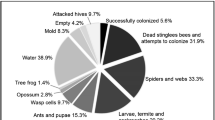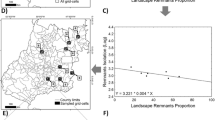Abstract
Natural habitat degradation often involves the reduction or disappearance of bee species. In Africa, stingless bees are hunted for honey, which is used as food, for medicinal purposes, and for traditional rituals. Severe habitat degradation due to human settlement is hypothesized to have a negative impact on the species diversity of the African stingless bee species. In this paper, we assess the impact of habitat degradation on the diversity of fve stingless bee species across different habitats in the tropical rainforest of Kenya (indigenous forest, mixed indigenous forest) and its neighbouring landscape (grassland, village) in western Kenya. The species fauna, nest occurrence, and species diversity of the stingless bee species varied across the different habitats. The number of nesting habitats of the meliponine species varied between habitats in the tropical rainforest. Meliponula ferruginea (reddish brown) nested in fve habitats, while Meliponula bocandei and Meliponula ferruginea (black) nested only in two habitat types. The species richness decreased within the different types of habitats and the indigenous and mixed indigenous forest contained more species than other habitats. The fauna composition in both homesteads was exclusively similar, while the indigenous and mixed indigenous forests were mostly similar. Similarity in habitat preferences for nesting was revealed between M. bocandei vs Plebeina hildebrandti and M. ferruginea (reddish brown) vs Hypotrigona gribodoi. The natural native indigenous forest had the most diverse community compared to the degraded habitats. There are taxon-specifc responses to habitat change; and in our study, there is clear value in conserving the native indigenous forest.
Similar content being viewed by others
References
Ayuke F. O., Karanja N. K., Muya E. M., Musombi B. K., Mungatu J. and Nyamasyo G. H. N. (2009) Macrofauna diversity and abundance across different land use systems in Embu, Kenya. Tropical and Subtropical Agroecosystems 11, 371–384.
Bommarco R., Biesmeijer J. C., Meyer B., Potts S. G., Pöyry J., Roberts S. P. M., Steffan Dewenter I. and Öckinger E. (2010) Dispersal capacity and diet breadth modify the response of wild bees to habitat loss. Proceedings of the Royal Society of London B: Biological Sciences 277, 2075–2082.
Boontop Y., Malaipan S., Chareansom K. and Wiwatwittaya D. (2008) Diversity of stingless bees (Apidae: Meliponini) in Thong Pha Phum District, Kanchanaburi Province, Thailand. The Kasetsart Journal (Natural Science) 42, 444–456.
Brosi B. J. (2009) The complex responses of social stingless bees (Apidae: Meliponini) to tropical deforestation. Forest Ecology and Management 258, 1830–1837.
Brosi B. J., Daily G. C.and Ehrlich P.(2007) Bee community shifts with landscape context in a tropical countryside. Ecological Applications 17, 418–430.
Brosi B. J., Daily G. C., Shih T. M., Oviedo F. and Duràn G. (2008) The effects of forest fragmentation on bee communities in tropical countryside. Journal of Applied Ecology 45, 773–783.
Canard A. and Poinsot D. (2004) Quelques méthods statistiques: typiques de l’étude des populations et des peuplements par la méthod des quadrats. Available online: https://doi.org/perso.univ-rennes1.fr/denis.poinsot/POP/Rapport_Penvins/instructions_et_conseils/poly%20Canard.pdf
Cortopassi-Laurino M., Imperatriz-Fonseca V. L., Roubik D. W., Dollin A., Heard T., Aguilar I. B., Venturieri G. C., Eardley C. and Nogueira-Neto P. (2006) Global meliponiculture: challenges and opportunities. Apidologie 37, 275–292.
Eardley C. D. (2004) Taxonomic revision of the African stingless bees (Apoidea: Apidae: Apinae: Meliponini). African Plant Protection 10, 63–96.
Eltz T., Bruhl C. A., Imiyabir Z. and Linsenmair K. E. (2003) Nesting and nest trees of stingless bees (Apidae: Meliponini) in lowland dipterocarp forests in Sabah, Malaysia, with implications for forest management. Forest Ecology and Management 172, 301–313.
Hubbell S. P. and Johnson L. K. (1977) Competition and nest spacing in a tropical stingless bee community. Ecology 58, 949–963.
Jongjitvimol T., Boontawon K., Wattanachaiyingcharoen W. and Deowanish S. (2005) Nest dispersion of a stingless bee species, Trigona collina Smith, 1857 (Apidae, Meliponinae) in a mixed deciduous forest in Thailand. The Natural History Journal of Chulalongkorn University 5, 69–71.
Kajobe R. (2007) Nesting biology of equatorial Afrotropical stingless bees (Apidae; Meliponini) in Bwindi Impenetrable National Park, Uganda. Journal of Apicultural Research 46, 245–255. doi: 10.3896/IBRA.1.46.4.07.
Kiatoko N., Raina S. K, Muli E., Klaus M. and Mueke J. (2012) Species richness and nest dispersion of some tropical meliponine bees (Apidae: Meliponinae) in six habitat types in the Kakamega forest, western Kenya. International Journal of Tropical Insect Science 32, 194–202. doi: 10.1017/S1742758412000355.
Kenya Indigenous Forest Conservation Programme (KIFCON) (1994) Kenya Indigenous Forest Conservation Programme. Phase 1 report. Karura Forest Station, Centre for Biodiversity, Nairobi.
Kindt R. and Coe R. (2005) Tree Diversity Analysis: A Manual and Software for Common Statistical Methods for Ecological and Biodiversity Studies. World Agroforestry Centre (ICRAF), Nairobi. 207 pp.
Kokwaro J. O. (1988) Conservation status of Kakamega forest in Kenya. The Eastern most relic of the equatorial rain forest of Africa. Monographs in Systematic Botany from the Missouri Botanical Garden 25, 471–489.
Krebs C. J. (1999) Ecological Methodology. 2nd edn. Adison-Wesley Publishers, Menlo Park, CA, USA. 620 pp.
Lepeletier de Saint-Fargeau A. L. M. (1841) Histoire Naturelle des Insectes. Hyménoptères Suites à Buffon. Roret 2, Paris. 680 pp.
Mbahin N. (2008) The ecology and economic potential of wild silkmoth Anaphe panda (Boisduval) (Lepidoptera: Thaumetopoeidae) in the Kakamega forest. PhD thesis, Kenyatta University, Nairobi, Kenya. 191 pp.
Michener C. D. (2000) The Bees of the World. Johns Hopkins University Press, USA. 913 pp.
Nates-Parra G., Palacios E. and Parra H. A. (2008) Effect of landscape change on the structure of the sting-less bee community (Hymenoptera: Apidae) in Meta, Colombia. Revista de Biología Tropical 56, 1295–1308.
Otieno N. A., Le Ru B. P., Ong’amo G. O., Moyal P., Dupas S., Calatayud P. A. and Silvain J. F. (2008) Diversity and abundance of wild host plants of lepidopteran stem borers in two agroecological zones of Kenya. The International Journal of Biodiversity Science and Management 4, 92–103. doi: 10.3843/Biodiv.4.2:3.
Pyper W. (2001). Six-legged friends. Ecos 107, 16–17.
Rasmussen C. (2009) Diversity and abundance of orchid bees (Hymenoptera: Apidae, Euglossini) in a tropical rainforest succession. Neotropical Entomology 38, 66–73.
R Development Core Team (2005) R: A Language and Environment for Statistical Computing. R Foundation for Statistical Computing, Vienna. Available at: https://doi.org/www.R-project.org
Ricketts T. H. (2004) Tropical forest fragments enhance pollinator activity in nearby coffee crops. Conservation Biology 18, 1262–1271.
Roubik W. D. (1989) Ecology and Natural History of Tropical Bees. Cambridge University Press, New York. 514 pp.
Samejima H., Marzuki M., Nagamitsu T. and Nakasizuka T. (2004) The effects of human disturbance on a stingless bee community in a tropical rainforest. Biological Conservation 120, 577–587.
Smith F. G. (1854) Catalogue of the Hymenopterous Insects in the Collection of the British Museum. Part II. Apidae. British Museum, London. 409 pp.
Tóthmérész B. (1995) Comparison of different methods for diversity ordering. Journal of Vegetation Science 6, 283–290.
Tsingalia H. M. (1988) Animals and the regeneration of a canopy tree in an African tropical forest. PhD thesis, University of California, Berkeley, USA.
Tsingalia H. M. (1990) Habitat disturbance, severity and patterns of abundance in Kakamega Forest, western Kenya. African Journal of Ecology 28, 213–226. doi:10.1111/j.1365-2028.1990.tb01154.x.
Tsingalia H. M. and Kassily F. N. (2009) The origins of Kakamega Forest grasslands: A critical review. Journal of Human Ecology 27, 129–135.
Velthuis H. H. W. (1997) The Biology of Stingless Bees. Utrecht University Press, Utrecht, The Netherlands. 33 pp.
Winfree R., Griswold T. and Kremen C. (2007) Effect of human disturbance on bee communities in a forested ecosystem. Conservation Biology 21, 213–223.
Author information
Authors and Affiliations
Corresponding author
Rights and permissions
About this article
Cite this article
Kiatoko, N., Raina, S.K. & van Langevelde, F. Impact of habitat degradation on species diversity and nest abundance of fve African stingless bee species in a tropical rainforest of Kenya. Int J Trop Insect Sci 37, 189–197 (2017). https://doi.org/10.1017/S174275841700011X
Accepted:
Published:
Issue Date:
DOI: https://doi.org/10.1017/S174275841700011X




